Designs of septic tanks without pumping: a review and comparison of 4 options among themselves
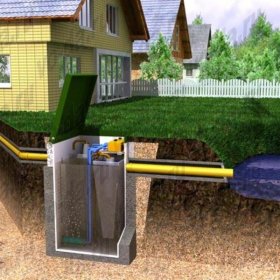
One of the conditions for comfortable living outside the city is the construction of a sewage system. Most often, septic tanks are used for these purposes. Those who want to save are building them on their own. Most of these structures need regular cleaning, for which it is necessary to call a cesspool machine. However, it is possible to make a septic tank with your own hands without pumping, for the maintenance of which you do not need to call special equipment. But first you need to find out the design features of such structures.
How does a non-pumping design work?
The design, which does not require regular pumping of wastewater, consists of several adjacent tanks. Usually build two or three-chamber septic tanks. The first tank is a sump. As a rule, in a two-chamber septic tank, the volume of the first tank occupies three quarters of the entire structure, in a three-chamber half.
Once in the first chamber, the effluent is pre-treated. In this case, the heavy fractions settle on the bottom, and the lighter ones flow into the second tank as the first is filled. In the last tank, final wastewater treatment takes place, after which relatively clean water is sent to the filtration fields or to the drainage well.

At the bottom of the last chamber of the septic tank, a layer of crushed stone is poured for drainage. This helps excess moisture go into the ground and does not accumulate in the septic tank.
All tanks of such a septic tank, except the last, are sealed. Depending on the design, holes are made in the last chamber in the walls or bottom of the septic tank. This helps to remove excess moisture and to avoid regular waste pumping.
Since in addition to organic substances there are insoluble impurities in domestic wastewater, even such a construction needs to be periodically disposed of from the sediment that will accumulate at the bottom of the septic tank. This is done using household drainage pumps. The pumped-out sediment can be used as fertilizer. The frequency of maintenance of the septic tank depends on its size and volume and composition of the effluent.
Determining the size and installation location of the septic tank
To build a septic tank for a cottage without pumping it is necessary to correctly calculate its volume. It is determined in accordance with water consumption. The basis is the rate of water consumption per person, which is 200 liters. daily. According to it, the daily norm for all residents is determined and the triple value of the obtained value is taken. Then add another 20% of the result.
After determining the volume, you need to calculate the size of the septic tank itself. Suppose you need a design with a volume of 18 m³. So you can build a septic tank 3 m deep, 3 m long and 2 m wide. Multiplication of all sides gives the desired volume. It must be borne in mind that the distance from the bottom of the structure to the drain pipe must be at least 0.8 m.
Also, it is very important to choose the right location for the structure.It is not recommended to approach the house closer than 5 meters. However, building too far from housing is also not worth it. Otherwise, it will increase the waste of laying the sewer line.
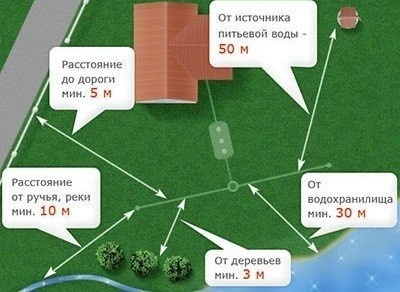
Since a septic tank is constructed without pumping, it is necessary to remove it from the water source by more than 50 m. In this case, the direction of movement of soil water should be taken into account. To avoid troubles with neighbors, it is required to deviate from the border of the plot by at least a meter
The longer the pipeline, the greater the likelihood of clogging. Therefore, you will have to install control wells.
Features of the device depending on the material
You can build a septic tank without pumping and odor yourself. To do this, apply:
- brick;
- monolithic concrete;
- concrete rings;
- Eurocubes.
Let's analyze each design in more detail.
Option # 1 - a brick septic tank
For the manufacture of a septic tank without pumping, clinker brick is chosen. The shape of the sump can be round or rectangular. It is advisable to treat the external walls of the septic tank for better waterproofing with special mastic and fill it with clay around the entire perimeter of about 20 cm. The inner surface is treated with cement mortar.
The bottom of the chambers, except the last one, must be concreted so that untreated waste does not seep into the ground. The bottom of the last tank is covered with a layer of sand and gravel, and the walls are laid out with small gaps. This will help excess filtered water seep into the ground. Between each other tanks are connected using tees.
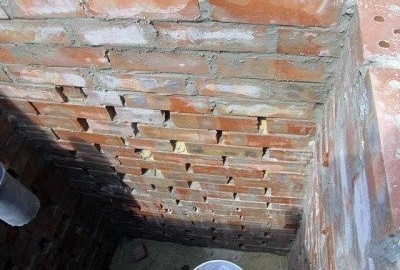
The walls of the last septic tank made of brick are laid out with small gaps so that excess moisture leaves through the soil through them
Option # 2 - monolithic concrete structure
For tightness of the first chambers of a monolithic septic tank, the base is poured with concrete on top of the sandy "pillow". After the mortar hardens, the formwork is constructed and the walls of the structure are poured with concrete. In this case, it is necessary to equip overflows between the cameras. For this, sewer tees are used. The top of the structure is also poured with mortar. At the same time, control holes are left, which are closed with hatches. To improve drainage, pipes are dug into the bottom of the last chamber, and the earth is not poured with mortar, but is covered with gravel.

The size of the first chamber of a three-chamber monolithic septic tank can be half of the entire structure or equal to each of its components. The walls and bottom of the monolithic structure must be completely tight
For the strength of concrete, when building a monolithic septic tank, it is necessary to use reinforcement.
Option # 3 - a septic tank made of concrete rings
The diameter of the reinforced concrete rings is different, which should be taken into account when calculating the size of the septic tank. Usually no more than 4 concrete products are used for one tank. Due to the severity of the constituent elements for the construction of such septic tanks, it is advisable to use special equipment. Bury the rings in series.
Having installed the first element at the location, make a dig under it. As the first ring is lowered, the following septic tank elements are installed. The parts are fastened together using protruding reinforcement. The seams between the rings are carefully sealed with mortar and waterproofed. The bottom of the sealed structures is concreted.
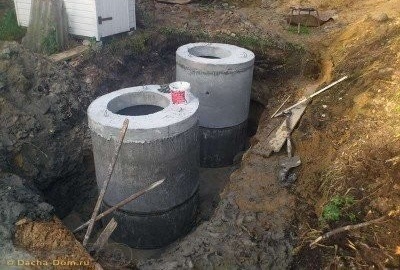
After installing the rings for the septic tank, the seams between them are sealed with a solution and covered with a waterproofing composition. This prevents untreated sewage from leaking into the soil.
To seal the joints between the rings, hydroisol, bituminous mastic, hydrotex or other waterproofing compounds are used.
Having thus built the right number of tanks, overflow pipes are laid between them. From above all cameras are closed with hatches. For reliability, a clay “lock” is made around the structure.
Option # 4 - use of plastic containers
Eurocubes are often used as plastic containers for septic tanks.Before installing them, it is necessary to make holes for the transitional and ventilation pipes. After that, the containers are welded or fastened together using fittings and lowered into a previously prepared foundation pit. To avoid extrusion of the structure with groundwater, it is necessary to anchor.

Eurocubes are fully prepared for installation in the ground. So that they do not move relative to each other, a strong metal frame is brewed
Regardless of what the septic tank is made of, it must be reliable and durable. We must not forget about the safety of such structures. Therefore, septic tanks without pumping can only be built in places with low groundwater levels.
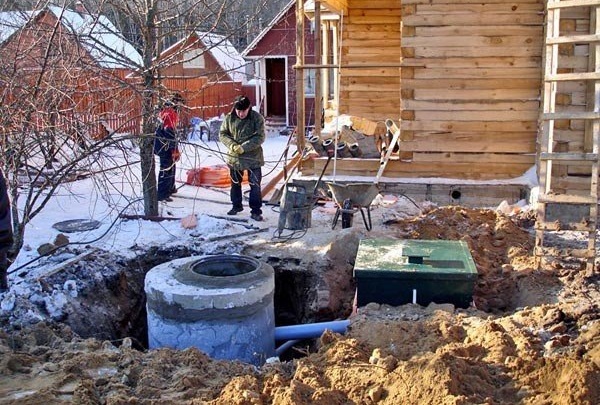

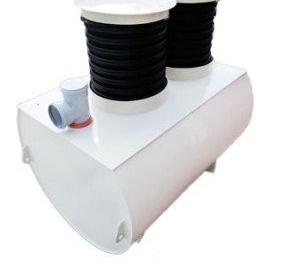
1 comment